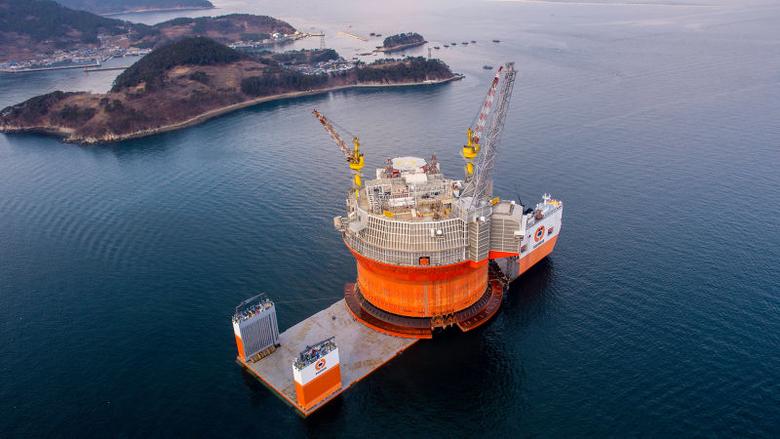
OFFSHORE OIL PRODUCTION: 30%

According to EIA, global offshore oil production (including lease condensate and hydrocarbon gas liquids) in 2015 was at the highest level since 2010, and accounted for nearly 30% of total global oil production. Offshore oil production increased in both 2014 and 2015, reversing consecutive annual declines from 2010 to 2013. Production from onshore tight oil plays has increased faster over the past several years and accounts for an increasing amount of total oil production.
More than 27 million barrels of oil were produced offshore in 2015 in more than 50 different countries. Global oil production is expected to remain high in 2016, as many oil-producing nations continue to increase production. A significant amount of global offshore production is concentrated in a few countries. In 2015, five countries provided 43% of total offshore oil production: Saudi Arabia, Brazil, Mexico, Norway, and the United States.
Saudi Arabia. The world's largest offshore producer has several large offshore oil fields including the Safaniya oil field, which produces between 1.1 and 1.5 million barrels per day and is the highest-producing offshore field in the world. Saudi Arabia is responsible for 13% of the world's total offshore production.
Brazil. Offshore production grew by 58% between 2005 and 2015, making Brazil the second-largest offshore producer in 2015. This growth was driven predominately by the expansion of deepwater pre-salt projects, which should support small production increases in 2016 and 2017.
Mexico. The third-largest offshore producer has seen increasingly smaller yields from offshore assets, with production falling by 31% from 2005 to 2015. Mexico, however, still produced nearly 2 million barrels per day in 2015, accounting for 7% of global offshore production.
Norway. Although offshore production declined 28% from 2005 to 2010, it has remained steady since 2010, with 7% of global offshore production originating from Norwegian fields. Norwegian output is forecast to rise slightly in 2016 and to fall slightly in 2017.
United States. Recent strong production in the Gulf of Mexico has increased offshore production. From 2005 to 2015, total offshore production grew by 6.5%. With several large projects coming online in 2016 and 2017, the Gulf of Mexico is expected to see production climb by about 0.1 million barrels per day (b/d) in 2016 and by an additional 0.2 million b/d in 2017. By contrast, U.S. onshore production is expected to fall by 0.8 million b/d in 2016 and by an additional 0.3 million b/d in 2017.
Most offshore production is in shallow waters, which are cheaper and less technically challenging, but there has also been a move toward deepwater projects. Exploratory drilling in deeper water is more costly and complex for companies, but technology advancements and the exhaustion of shallower prospects have led companies to explore increasingly deeper waters, particularly in Brazil and in the Gulf of Mexico.
-----
Earlier:
INTERNATIONAL RIG COUNT DOWN 200
Nigeria's oil production has risen to 1.9 million b/d, the oil ministry said Tuesday, even as the government has begun moves for all-inclusive talks with Niger Delta leaders to end militancy in the region and bolster oil production.
"We have built capacity of up to 2.4 million b/d, but [we are] currently producing about 1.9 million b/d," Omar Farouk, the special adviser on international energy relations to Nigeria's oil minister of state, said on the ministry's twitter handle.
Farouk said Nigeria was in urgent need of new investments to increase its reserve base and output.
"Nigeria has produced over 10 billion barrels of oil since the year 2000. However, we have not discovered this much in the same period," he said.
Nigerian oil output plummeted to near 30-year lows of around 1.5 million-1.6 million b/d in August, according to government estimates, from 2.2 million b/d earlier in the year as attacks on oil facilities in the Niger Delta rose at an alarming pace amid resurgent militancy.
The sharp drop in oil production has severely hurt Nigeria's economy, already exacerbated by the slump in global oil prices.
Militant group Niger Delta Avengers, responsible for most of the attacks on oil facilities that cut Nigerian production by more than 700,000 b/d, said late in September it was abandoning its ceasefire announced September 2 over what it said was the Nigerian government's failure to respond to its peace overtures.
Some other militant groups, including the self-styled Greenland Justice Mandate, have been carrying out pockets of attacks on pipelines operated by state-owned Nigerian National Petroleum Corp.
A presidential aide confirmed Tuesday that a government team would commence on October 31 talks with "all stakeholders in the Niger Delta region," including community leaders and youth organizations, to end the attacks on oil installations.
Nigerian President Muhammadu Buhari said on October 10 that the peace talks had not got off the ground, because the government was trying to identify the actual leaders and groups to negotiate with.
NNPC and oil ministry officials have said they expect the country's oil output to climb to around 2 million b/d by the end of this year.
-----
Earlier:
CHINESE - NIGERIAN AGREEMENTS: $80 BLN







